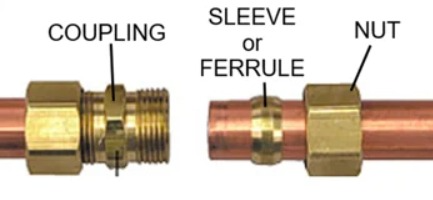Fittings play a crucial role in fluid systems and industrial applications. Their performance and reliability are key factors for success. Our focus shifts to compression fittings, resilient guardians of pressure.
We explore their intricate mechanics and factors influencing pressure resistance. Join us on a journey to understand their crucial role.
How Compression Fittings Work
Compression fittings operate on a simple yet effective principle. The compression nut, ferrule, and body work together to create a tight seal. They do this by compressing the fitting onto the tubing. The ferrule plays a critical role, distributing pressure evenly for a secure connection. Understanding these components is vital for evaluating a compression fitting’s pressure-holding capabilities.
Are Compression Fittings Strong?
The strength of compression fittings is remarkable. Their robust design ensures reliability in various applications. Compression fittings can handle a lot of pressure when installed correctly. They are a good choice for various industries if guidelines are followed.
Pressure Basics
In compression systems, pressure is the force applied over a specific area. The units of measurement, such as PSI (pounds per square inch) or bar, provide insights into the intensity of force. These measurements are crucial in determining the pressure resistance of compression fittings.
How Reliable Are Compression Fittings?
Compression fittings are highly reliable when used within their specified limits. The dependability of products can be affected by various factors. These factors include the choice of materials, size, configuration, and operating temperature. Considering these aspects properly ensures the fittings perform well and endure pressure.
Factors Influencing Pressure Holding Capacity
A. Material Selection
The material of a compression fitting significantly impacts its pressure-holding capacity. Stainless steel, brass, and copper are common choices. Each has distinct characteristics that contribute to their resilience under pressure.
B. Size and Configuration Options
The size and configuration of compression fittings play a pivotal role in determining their pressure capabilities. Understanding the requirements is crucial for reliable performance of an application. Selecting the appropriate size and design is also important.
C. Temperature Considerations
Temperature variations can affect the performance of compression fittings. It is essential to evaluate the temperature conditions for fittings. This helps predict their pressure-handling capabilities accurately.
Maximum Pressure for Common Materials
A. Stainless Steel Compression Fittings
Stainless steel compression fittings boast exceptional strength and corrosion resistance. They can handle high pressures, making them suitable for demanding environments.
B. Brass Compression Fittings
Brass compression fittings offer a balance of strength and malleability. The pressure ratings of these make them ideal for many uses. They balance reliability and versatility harmoniously.
C. Copper Compression Fittings
Copper compression fittings, known for their excellent conductivity, exhibit substantial pressure resistance. Their reliability in different industries is proven by their ability to resist strong impact.
Selecting the Right Compression Fitting
A. Matching Fitting to Application
Selecting the right compression fitting involves understanding the specific requirements of the application. Factors like fluid type, pressure levels, and environmental conditions guide the selection process.
B. Consulting Pressure Rating Charts
Pressure rating charts provided by manufacturers serve as valuable resources. The charts provide maximum pressure for each fitting. This information helps with decision-making during the selection process.
Safety Guidelines
A. Importance of Adhering to Safety Protocols
Safety is paramount when working with compression fittings. Adhering to safety protocols ensures secure installations. It also minimizes the risk of accidents or leaks.
B. Tips for Ensuring Leak-Free Connections
Proper installation techniques are crucial to avoid leaks. This includes appropriate tightening and inspection procedures for connections. Regular maintenance checks further contribute to the reliability of compression fittings.
Conclusion
It is essential to understand how much pressure compression fittings can hold. This understanding is necessary for their effective and safe utilization. Users can confidently select and install compression fittings. They should grasp the mechanics, consider influencing factors, and adhere to safety guidelines. These fittings will meet the demands of their applications. These fittings are reliable when used with proper considerations. They are integral components in various industries.
Post time: Jan-19-2024


